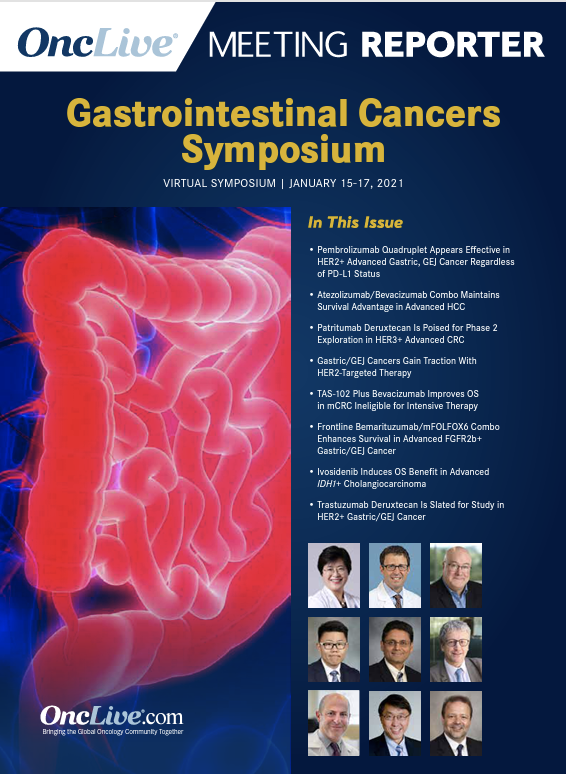Publication
Article
Supplements and Featured Publications
Atezolizumab/Bevacizumab Combo Maintains Survival Advantage in Advanced HCC
Author(s):
January 17, 2021 - The combination of atezolizumab and bevacizumab continued to display improved survival compared with sorafenib in previously untreated patients with advanced hepatocellular carcinoma.
Richard S. Finn, MD

The combination of atezolizumab (Tecentriq) and bevacizumab (Avastin) continued to display improved survival compared with sorafenib (Nexavar) in previously untreated patients with advanced hepatocellular carcinoma (HCC), according to updated findings from the phase 3 IMbrave150 trial that were presented during the 2021 Gastrointestinal Cancers Symposium.
At a median follow-up of 15.6 months, the median overall survival (OS) was 19.2 months with the combination versus 13.4 months with sorafenib (HR, 0.66; 95% CI, 0.52-0.85; P = .0009). The median progression-free survival (PFS) was 6.9 months versus 4.3 months, respectively (HR, 0.65; 95% CI, 0.53-0.81; P = .0001).
“The median survival for atezolizumab/bevacizumab is now over 19 months. This is the longest survival seen in a phase 3 study of advanced liver cancer,” lead study author, Richard S. Finn, MD, professor of clinical medicine, Department of Medicine, Division of Hematology/Oncology, Geffen School of Medicine, University of California, Los Angeles (UCLA), and director of the Signal Transduction and Therapeutics Program at the UCLA Jonsson Comprehensive Cancer Center, said in a virtual presentation of the data during the meeting.
In May 2020, the FDA approved the combination for patients with unresectable or metastatic HCC who have not received prior systemic therapy based on findings from the primary analysis of the IMbrave150 study in which both coprimary end points of PFS (HR, 0.59) and OS (HR, 0.58) were met.
The global, multicenter, randomized, open-label study enrolled 501 treatment-naive patients with locally advanced or metastatic and/or unresectable HCC and randomized them 2:1 to 1200 mg of intravenous (IV) atezolizumab every 3 weeks plus 15 mg/kg of IV bevacizumab every 3 weeks (n = 336) or 400 mg of sorafenib twice daily (n = 165) until unacceptable toxicity or loss of clinical benefit.
Eligible patients had 1 or more measurable untreated lesions per RECIST 1.1 criteria, Child-Pugh class A liver function and an ECOG performance status of 0 or 1.
Updated patient disposition indicated that 40% of patients in the combination arm remain on study versus 26% in the sorafenib arm; 18% and 3% of patients remain on treatment, respectively. Sixty percent of patients in the combination arm have discontinued the study versus 74% in the sorafenib arm, primarily because of death (53% and 60%, respectively).
“The baseline characteristics have not changed from the primary analysis. The majority of patients came from outside of Asia and had high-risk features, such as an elevated alpha-fetoprotein, macrovascular invasion, or extrahepatic spread,” said Finn.
With an additional 12 months of follow-up, the updated results also demonstrated an 18-month OS rate of 52% with the combination versus 40% with sorafenib. The 18-month PFS rates were 24% and 12%, respectively.
“We see with longer follow-up that we have more responses with atezolizumab/bevacizumab than initially reported,” said Finn.
The confirmed objective response rate by RECIST v1.1 criteria was 30% with the combination versus 11% with sorafenib, with complete response rates of 8% and less than 1%, respectively. The disease-control rate was 74% with the combination versus 55% with sorafenib.
The median duration of response was 18.1 months with the combination versus 14.9 months with sorafenib. Fifty-six percent of patients in the combination arm had an ongoing response at the clinical cutoff versus 28% of patients in the sorafenib arm.
Regarding follow-up systemic therapy for HCC, 36% of patients in the combination arm had at least 1 subsequent systemic therapy versus 52% of patients in the sorafenib arm. Types of follow-up therapies included TKIs (32% versus 33%, respectively), immunotherapy (3% versus 26%, respectively), chemotherapy (3% versus 9%, respectively), angiogenesis inhibitors (2% versus 6%, respectively), among others (2% versus 4%, respectively).
In the Chinese cohort (n = 194), the median OS was 24.0 months in the combination arm versus 11.4 months in the sorafenib arm (stratified HR, 0.53; 95% CI, 0.35-0.80). The 18-month OS rates were 56% and 33%, respectively.
In terms of safety, all-grade treatment-related adverse effects (TRAEs) occurred in 86% of patients in the combination arm versus 95% of patients in the sorafenib arm. The rates of grade 3/4 TRAEs were 43% and 46%, respectively. Grade 5 TRAEs occurred in 2% of patients in the combination arm versus less than 1% in the sorafenib arm.
AEs leading to withdrawal from any component of treatment occurred in 22% of patients in the combination arm versus 12% in the sorafenib arm. AEs leading to dose interruption of any study treatment occurred in 59% and 44% of patients, respectively.
“The safety and tolerability of the combination remains consistent with what we saw in the primary analysis,” concluded Finn.
Reference
- Finn RS, Qin S, Ikeda M, et al. IMbrave150: updated overall survival (OS) data from a global, randomized, open-label phase III study of atezolizumab (atezo) + bevacizumab (bev) vs sorafenib (sor) in patients (pts) with unresectable hepatocellular carcinoma (HCC). J Clin Oncol. 2021;39(suppl 3):267. http://bit.ly/2LVd9Mu.










